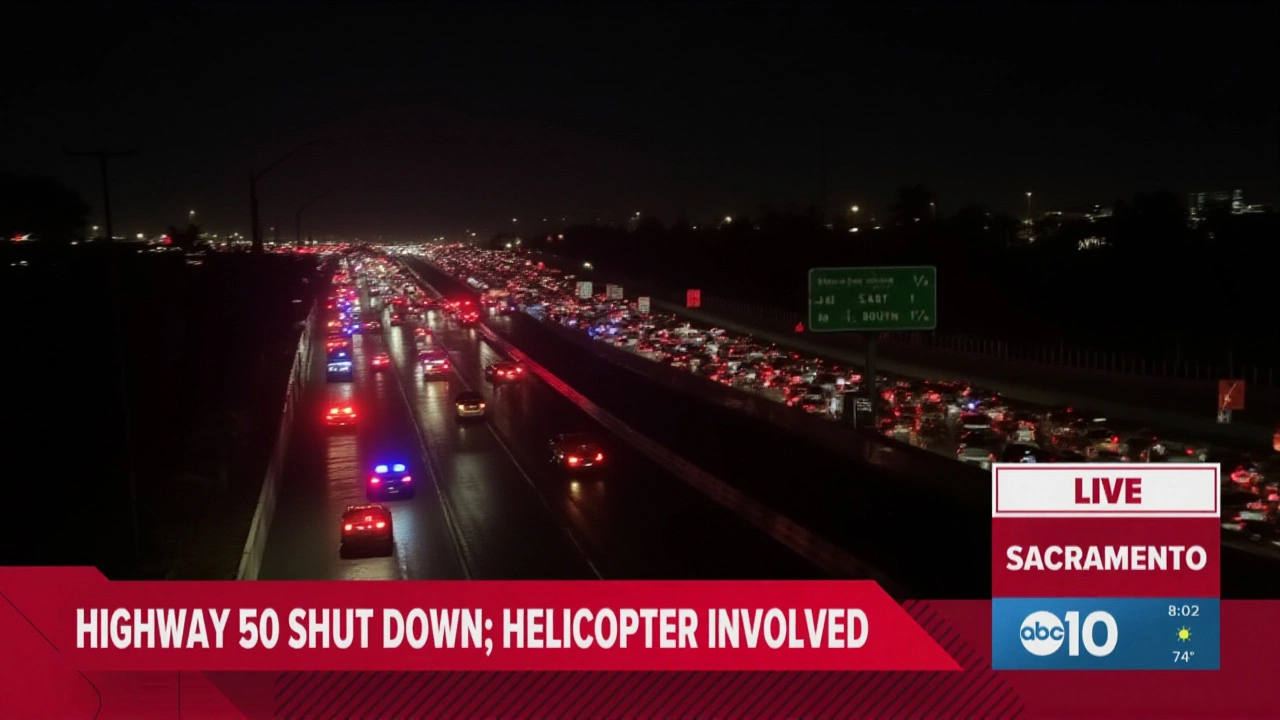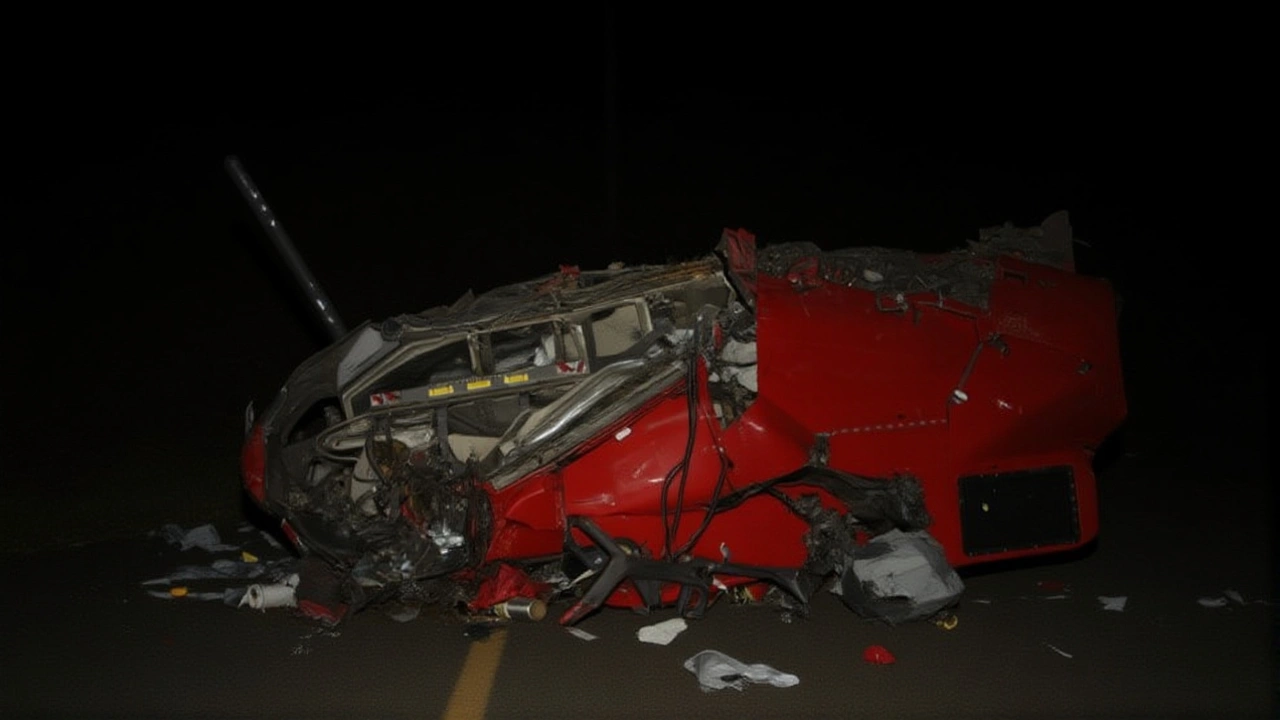Pilot, Nurse, Paramedic Critically Injured After Reach Air Helicopter Crashes on Sacramento’s Highway 50

When Michael Torres, the pilot for Reach Air Medical Services, touched down on the eastbound lanes of Highway 50 near Stockton Boulevard in Sacramento at roughly 7:03 p.m. on Monday, October 6, 2025, the aircraft nosedive that followed left three crew members in critical condition.
The crew consisted of Emily Chen, a registered nurse, and Luis Ramirez, a paramedic, both also employed by Reach Air Medical Services. None of the three were transporting a patient at the time; they had just delivered one to UC Davis Medical Center and were heading back to base when the helicopter struck the roadway.
What Happened on Highway 50?
Witnesses say the rotor blades slowed abruptly before the aircraft tilted forward and slammed into the concrete. "It looked like it lost lift and just went down straight," recalled Sandra Miller, who was stuck in traffic at the time. By the time emergency crews arrived, the helicopter was partially embedded in the median, its rotors still turning slowly.
First‑responders from the Sacramento Fire Department and the California Highway Patrol (CHP) reported that the three crew members were extricated within 15 minutes, thanks in large part to drivers who leapt from their cars to pull the crew from the wreckage.
Immediate Response and Medical Care
"The community’s quick action saved lives," said Fire Chief Rita Delgado in a briefing at 7:45 p.m. She added that paramedics from the fire department began life‑saving measures on site before the victims were loaded onto ambulances.
All three were rushed to nearby hospitals—Torres to Sacramento Regional Medical Center, Chen to St. Joseph’s Hospital, and Ramirez to Sutter Medical Center. Each remains in critical condition, according to hospital spokespersons.
Impact on Traffic and Local Community
The crash forced the closure of three of the four eastbound lanes on Highway 50 for nearly six hours. Traffic engineers rerouted thousands of commuters onto alternate routes, causing an estimated 2‑hour delay for morning‑evening commuters. By 11:30 p.m., crews had cleared most debris, but a single lane remained open for emergency vehicles until midnight.
Local businesses reported a surge in sales of coffee and bottled water as drivers waited in line. "We saw a 30 % jump in sales between 7 p.m. and 9 p.m.," said Maria Vega, owner of a nearby café. The unexpected slowdown also gave residents a rare glimpse of the downtown corridor without the usual rush‑hour roar.
Investigation into the Crash
The CHP launched a formal investigation, citing possible mechanical failure or pilot error. Engineers from the Federal Aviation Administration (FAA) are scheduled to examine the wreckage on October 7. "We’ll be looking at the rotor system, engine performance, and the flight data recorder," said CHP spokesperson Mark Jensen on a press conference.
Reach Air Medical Services released a statement expressing gratitude for the heroic actions of bystanders and first responders. "Our thoughts are with the crew and their families," the statement read. The company, which operates a fleet of ten helicopters across California, has a safety record of 99.7 % flight completion over the past decade.

Background on Reach Air Medical Services
Founded in 2008, Reach Air Medical Services provides critical‑care transport for patients in remote or traffic‑congested areas. Their helicopters are equipped with advanced life‑support equipment, allowing nurses and paramedics to provide ICU‑level care en route.
According to a 2023 report by the California Department of Health, medical‑transport helicopters performed over 12,000 missions statewide, saving an estimated 3,500 lives annually. The Sacramento hub, where the crash occurred, handles roughly 1,200 flights per year—mostly inter‑facility transfers.
Looking Ahead: Safety Measures and Community Preparedness
In the wake of the accident, local officials are urging airlines and helicopter operators to review emergency response protocols. A joint task force, comprising the CHP, FAA, and Reach Air, will convene next week to discuss possible improvements to flight‑path monitoring over densely populated corridors.
Meanwhile, community groups are planning a fundraiser for the injured crew. "We want to show our support beyond the headlines," said volunteer organizer Jenna Liu, who is coordinating a charity run scheduled for November 12.
- Date & time: October 6, 2025, 7:03 p.m.
- Location: Eastbound Highway 50 near Stockton Boulevard, Sacramento, CA
- Crew members injured: Pilot Michael Torres, Nurse Emily Chen, Paramedic Luis Ramirez
- Organizations involved: Reach Air Medical Services, California Highway Patrol, Sacramento Fire Department, UC Davis Medical Center
- Current status: All three crew members in critical condition; investigation ongoing
Frequently Asked Questions
Why were there no patients on board the helicopter?
The crew had just completed a transport from UC Davis Medical Center and were returning to base when the crash occurred. The patient was safely delivered before the aircraft took off again, so the flight was empty at the time of the accident.
What caused the helicopter to nosedive?
The exact cause is still under investigation by the California Highway Patrol and the FAA. Early speculation points to a possible mechanical malfunction in the rotor system, but officials have not ruled out pilot error or adverse weather conditions.
How long did it take for emergency services to reach the crash site?
First responders arrived within three minutes of the reported impact. Bystanders helped free the crew, and all three were air‑lifted to hospitals within 20 minutes of the crash.
Will this incident affect Reach Air’s operations?
Reach Air Medical Services has temporarily grounded its Sacramento‑based helicopter pending the investigation’s outcome. The company says it will resume flights as soon as safety can be assured.
What steps are being taken to prevent similar crashes?
A joint task force of the CHP, FAA, and Reach Air will review flight‑path regulations, helicopter maintenance logs, and crew training protocols. Recommendations could include stricter altitude limits over urban highways and enhanced real‑time monitoring of aircraft systems.